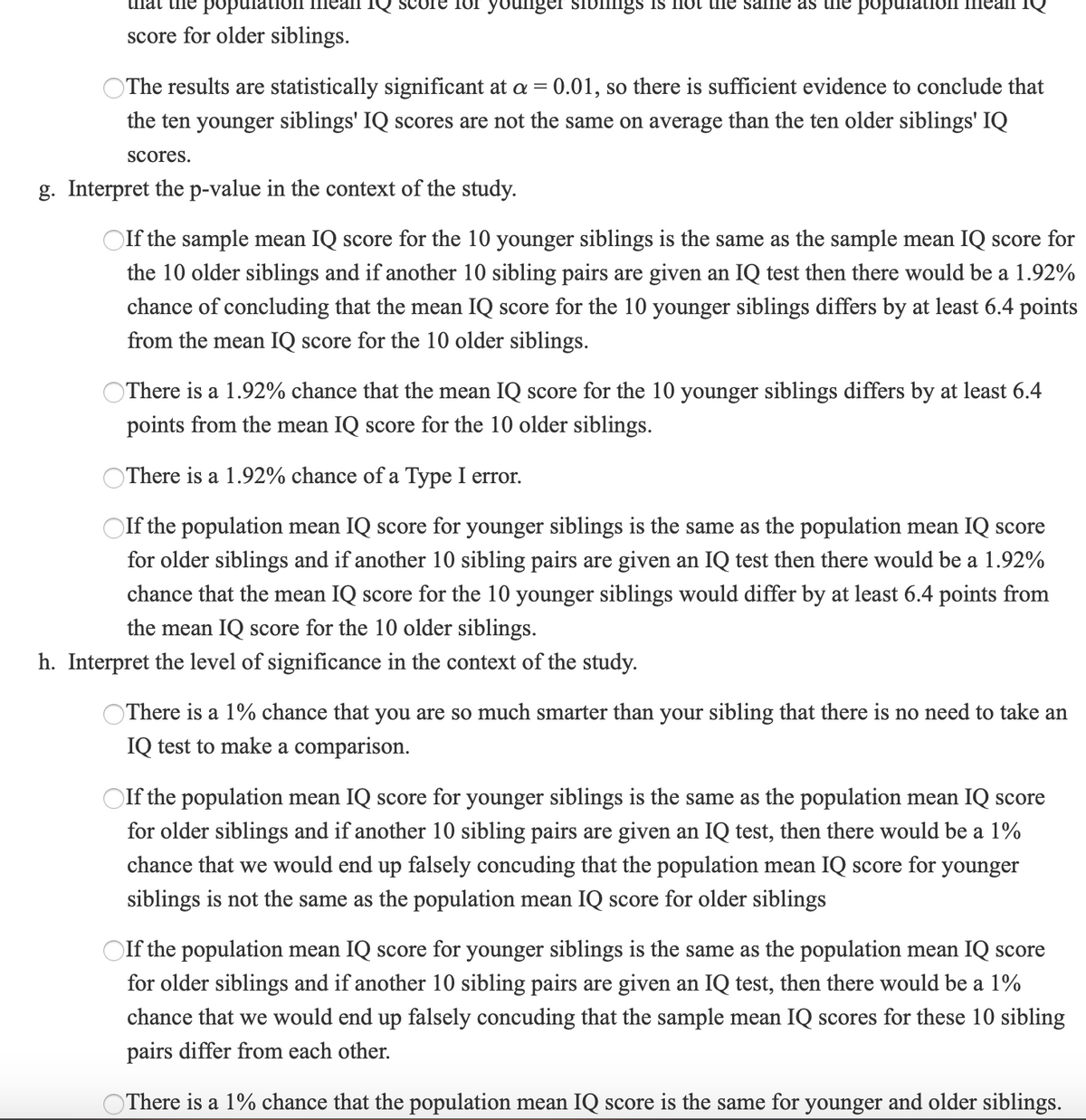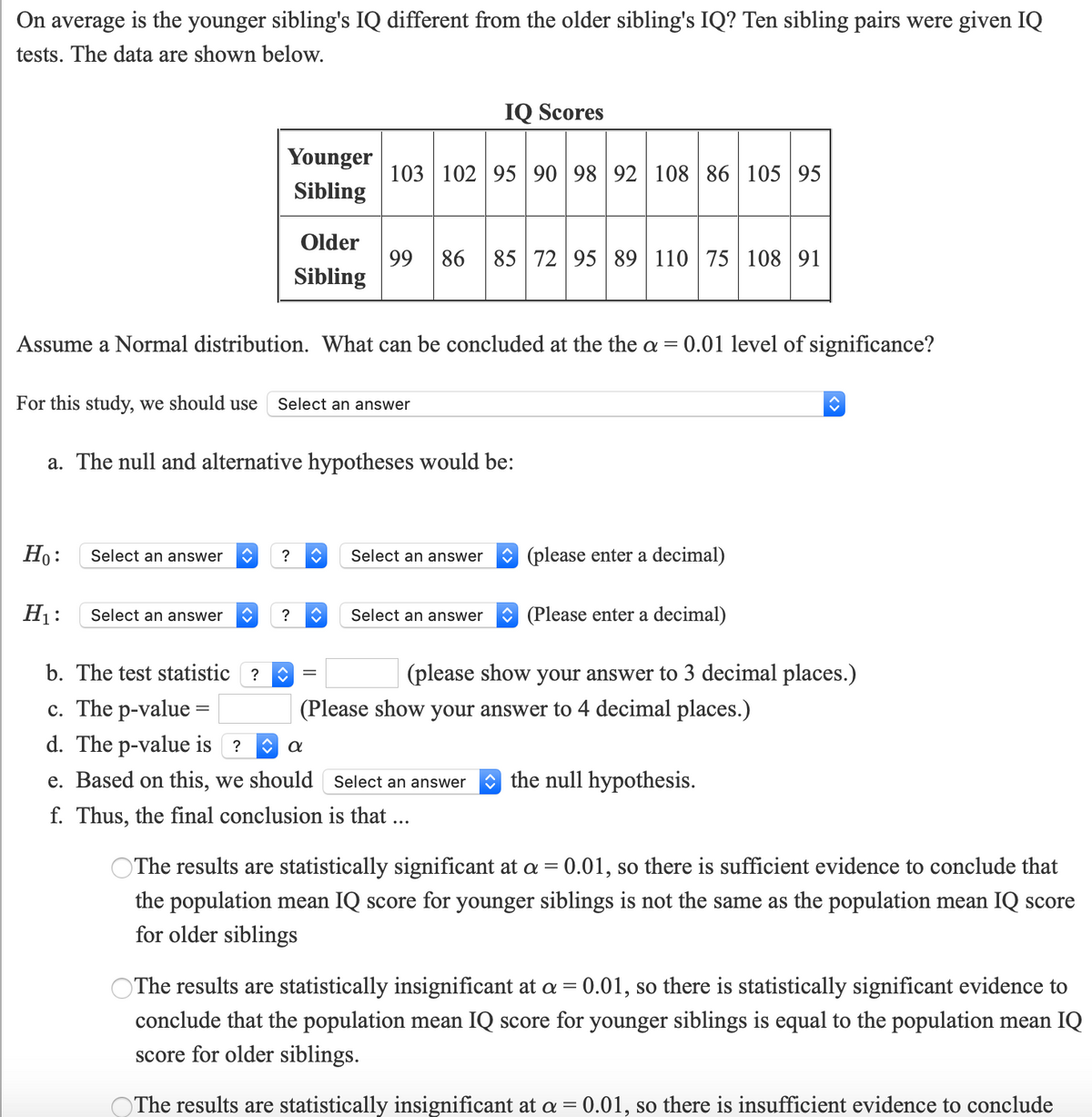e. Based on this, we should O the null hypothesis. Select an answer f. Thus, the final conclusion is that ... The results are statistically significant at a = 0.01, so there is sufficient evidence to conclude that the population mean IQ score for younger siblings is not the same as the population mean IQ score for older siblings The results are statistically insignificant at a = 0.01, so there is statistically significant evidence to conclude that the population mean IQ score for younger siblings is equal to the population mean IQ score for older siblings. OThe results are statistically insignificant at a = 0.01, so there is insufficient evidence to conclude
e. Based on this, we should O the null hypothesis. Select an answer f. Thus, the final conclusion is that ... The results are statistically significant at a = 0.01, so there is sufficient evidence to conclude that the population mean IQ score for younger siblings is not the same as the population mean IQ score for older siblings The results are statistically insignificant at a = 0.01, so there is statistically significant evidence to conclude that the population mean IQ score for younger siblings is equal to the population mean IQ score for older siblings. OThe results are statistically insignificant at a = 0.01, so there is insufficient evidence to conclude
Glencoe Algebra 1, Student Edition, 9780079039897, 0079039898, 2018
18th Edition
ISBN:9780079039897
Author:Carter
Publisher:Carter
Chapter10: Statistics
Section10.4: Distributions Of Data
Problem 19PFA
Related questions
Question
NEED HELP With; e,f ,g

Transcribed Image Text:popu
for younger sibllngs Is not he same as the populat.
score for older siblings.
OThe results are statistically significant at a = 0.01, so there is sufficient evidence to conclude that
the ten younger siblings' IQ scores are not the same on average than the ten older siblings' IQ
scores.
g. Interpret the p-value in the context of the study.
Olf the sample mean IQ score for the 10 younger siblings is the same as the sample mean IQ score for
the 10 older siblings and if another 10 sibling pairs are given an IQ test then there would be a 1.92%
chance of concluding that the mean IQ score for the 10 younger siblings differs by at least 6.4 points
from the mean IQ score for the 10 older siblings.
OThere is a 1.92% chance that the mean IQ score for the 10 younger siblings differs by at least 6.4
points from the mean IQ score for the 10 older siblings.
OThere is a 1.92% chance of a Type I error.
OIf the population mean IQ score for younger siblings is the same as the population mean IQ score
for older siblings and if another 10 sibling pairs are given an IQ test then there would be a 1.92%
chance that the mean IQ score for the 10 younger siblings would differ by at least 6.4 points from
the mean IQ score for the 10 older siblings.
h. Interpret the level of significance in the context of the study.
OThere is a 1% chance that you are so much smarter than your sibling that there is no need to take an
IQ test to make a comparison.
If the population mean IQ score for younger siblings is the same as the population mean IQ score
for older siblings and if another 10 sibling pairs are given an IQ test, then there would be a 1%
chance that we would end up falsely concuding that the population mean IQ score for younger
siblings is not the same as the population mean IQ score for older siblings
Olf the population mean IQ score for younger
is the same as the popu
tion mean IQ score
for older siblings and if another 10 sibling pairs are given an IQ test, then there would be a 1%
chance that we would end up falsely concuding that the sample mean IQ scores for these 10 sibling
pairs differ from each other.
OThere is a 1% chance that the population mean IQ score is the same for younger and older siblings.

Transcribed Image Text:On average is the younger sibling's IQ different from the older sibling's IQ? Ten sibling pairs were given IQ
tests. The data are shown below.
IQ Scores
Younger
103 102 9590 98 92 108 86 105 95
Sibling
Older
99 86 85 72 95 89 110 75 108 91
Sibling
Assume a Normal distribution. What can be concluded at the the a =
0.01 level of significance?
For this study, we should use
Select an answer
a. The null and alternative hypotheses would be:
Но:
Select an answer
O (please enter a decimal)
?
Select an answer
H1:
O (Please enter a decimal)
Select an answer
?
Select an answer
b. The test statistic ?
(please show your answer to 3 decimal places.)
c. The p-value =
d. The p-value is ?
(Please show your answer to 4 decimal places.)
e. Based on this, we should Select an answer
O the null hypothesis.
f. Thus, the final conclusion is that ...
The results are statistically significant at a = 0.01, so there is sufficient evidence to conclude that
%3D
the population mean IQ score for younger siblings is not the same as the population mean IQ score
for older siblings
The results are statistically insignificant at a = 0.01, so there is statistically significant evidence to
conclude that the population mean IQ score for younger siblings is equal to the population mean IQ
score for older siblings.
The results are statistically insignificant at a = 0.01, so there is insufficient evidence to conclude
Expert Solution
Step 1
Let denote the IQ score for younger and Older sibling respectively.
The sample size is n = 10.
From the sample values given, we can calculate the following
Level of significance,
Step by step
Solved in 2 steps

Knowledge Booster
Learn more about
Need a deep-dive on the concept behind this application? Look no further. Learn more about this topic, statistics and related others by exploring similar questions and additional content below.Recommended textbooks for you

Glencoe Algebra 1, Student Edition, 9780079039897…
Algebra
ISBN:
9780079039897
Author:
Carter
Publisher:
McGraw Hill

Glencoe Algebra 1, Student Edition, 9780079039897…
Algebra
ISBN:
9780079039897
Author:
Carter
Publisher:
McGraw Hill